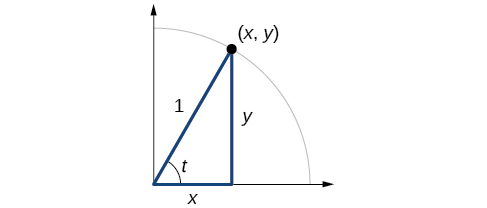
In this section, you will:
and
We have previously defined the sine and cosine of an angle in terms of the coordinates of a point on the unit circle intersected by the terminal side of the angle:
In this section, we will see another way to define trigonometric functions using properties of right triangles.
In earlier sections, we used a unit circle to define the trigonometric functions. In this section, we will extend those definitions so that we can apply them to right triangles. The value of the sine or cosine function of
is its value at
radians. First, we need to create our right triangle. [link] shows a point on a unit circle of radius 1. If we drop a vertical line segment from the point
to the x-axis, we have a right triangle whose vertical side has length
and whose horizontal side has length
We can use this right triangle to redefine sine, cosine, and the other trigonometric functions as ratios of the sides of a right triangle.

We know
Likewise, we know
These ratios still apply to the sides of a right triangle when no unit circle is involved and when the triangle is not in standard position and is not being graphed using
coordinates. To be able to use these ratios freely, we will give the sides more general names: Instead of
we will call the side between the given angle and the right angle the adjacent side to angle
(Adjacent means “next to.”) Instead of
we will call the side most distant from the given angle the opposite side from angle
And instead of
we will call the side of a right triangle opposite the right angle the hypotenuse. These sides are labeled in [link].

Given a right triangle with an acute angle of
A common mnemonic for remembering these relationships is SohCahToa, formed from the first letters of “Sine is opposite over hypotenuse, Cosine is adjacent over hypotenuse, Tangent is opposite over adjacent.”
Given the side lengths of a right triangle and one of the acute angles, find the sine, cosine, and tangent of that angle.
Given the triangle shown in [link], find the value of
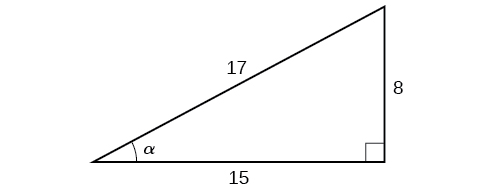
The side adjacent to the angle is 15, and the hypotenuse of the triangle is 17, so:
Given the triangle shown in [link], find the value of
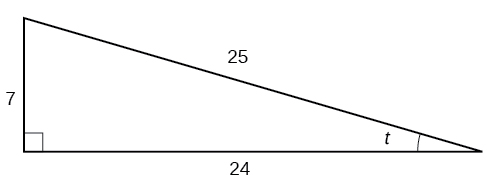
When working with right triangles, the same rules apply regardless of the orientation of the triangle. In fact, we can evaluate the six trigonometric functions of either of the two acute angles in the triangle in [link]. The side opposite one acute angle is the side adjacent to the other acute angle, and vice versa.
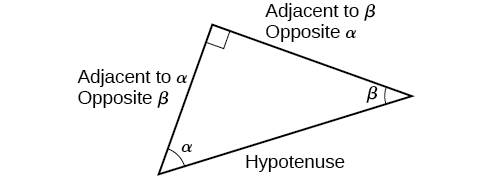
We will be asked to find all six trigonometric functions for a given angle in a triangle. Our strategy is to find the sine, cosine, and tangent of the angles first. Then, we can find the other trigonometric functions easily because we know that the reciprocal of sine is cosecant, the reciprocal of cosine is secant, and the reciprocal of tangent is cotangent.
Given the side lengths of a right triangle, evaluate the six trigonometric functions of one of the acute angles.
Using the triangle shown in [link], evaluate
and

We have already discussed the trigonometric functions as they relate to the special angles on the unit circle. Now, we can use those relationships to evaluate triangles that contain those special angles. We do this because when we evaluate the special angles in trigonometric functions, they have relatively friendly values, values that contain either no or just one square root in the ratio. Therefore, these are the angles often used in math and science problems. We will use multiples of
and
however, remember that when dealing with right triangles, we are limited to angles between
Suppose we have a
triangle, which can also be described as a
triangle. The sides have lengths in the relation
The sides of a
triangle, which can also be described as a
triangle, have lengths in the relation
These relations are shown in [link].

We can then use the ratios of the side lengths to evaluate trigonometric functions of special angles.
Given trigonometric functions of a special angle, evaluate using side lengths.
Find the exact value of the trigonometric functions of
using side lengths.
Find the exact value of the trigonometric functions of
using side lengths.
If we look more closely at the relationship between the sine and cosine of the special angles relative to the unit circle, we will notice a pattern. In a right triangle with angles of
and
we see that the sine of
namely
is also the cosine of
while the sine of
namely
is also the cosine of
See [link]
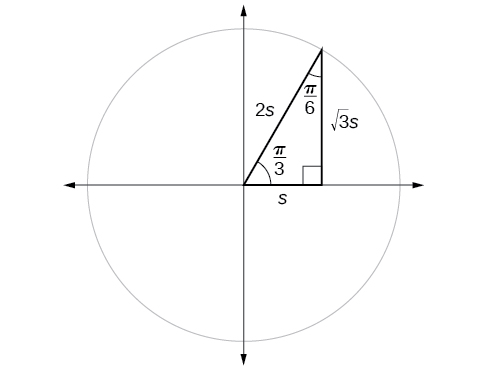
This result should not be surprising because, as we see from [link], the side opposite the angle of
is also the side adjacent to
so
and
are exactly the same ratio of the same two sides,
and
Similarly,
and
are also the same ratio using the same two sides,
and
The interrelationship between the sines and cosines of
and
also holds for the two acute angles in any right triangle, since in every case, the ratio of the same two sides would constitute the sine of one angle and the cosine of the other. Since the three angles of a triangle add to
and the right angle is
the remaining two angles must also add up to
That means that a right triangle can be formed with any two angles that add to
—in other words, any two complementary angles. So we may state a cofunction identity: If any two angles are complementary, the sine of one is the cosine of the other, and vice versa. This identity is illustrated in [link].
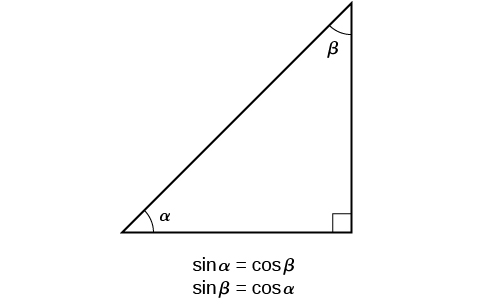
Using this identity, we can state without calculating, for instance, that the sine of
equals the cosine of
and that the sine of
equals the cosine of
We can also state that if, for a certain angle
then
as well.
Given the sine and cosine of an angle, find the sine or cosine of its complement.
If
find
According to the cofunction identities for sine and cosine,
So
If
find
2
In previous examples, we evaluated the sine and cosine in triangles where we knew all three sides. But the real power of right-triangle trigonometry emerges when we look at triangles in which we know an angle but do not know all the sides.
Given a right triangle, the length of one side, and the measure of one acute angle, find the remaining sides.
Find the unknown sides of the triangle in [link].
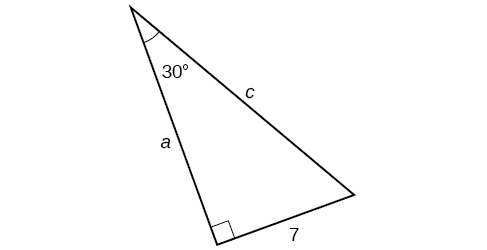
We know the angle and the opposite side, so we can use the tangent to find the adjacent side.
We rearrange to solve for
We can use the sine to find the hypotenuse.
Again, we rearrange to solve for
A right triangle has one angle of
and a hypotenuse of 20. Find the unknown sides and angle of the triangle.
; missing angle is
Right-triangle trigonometry has many practical applications. For example, the ability to compute the lengths of sides of a triangle makes it possible to find the height of a tall object without climbing to the top or having to extend a tape measure along its height. We do so by measuring a distance from the base of the object to a point on the ground some distance away, where we can look up to the top of the tall object at an angle. The angle of elevation of an object above an observer relative to the observer is the angle between the horizontal and the line from the object to the observer's eye. The right triangle this position creates has sides that represent the unknown height, the measured distance from the base, and the angled line of sight from the ground to the top of the object. Knowing the measured distance to the base of the object and the angle of the line of sight, we can use trigonometric functions to calculate the unknown height. Similarly, we can form a triangle from the top of a tall object by looking downward. The angle of depression of an object below an observer relative to the observer is the angle between the horizontal and the line from the object to the observer's eye. See [link].
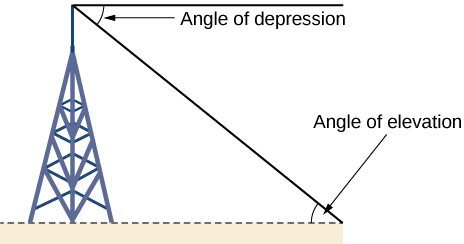
Given a tall object, measure its height indirectly.
To find the height of a tree, a person walks to a point 30 feet from the base of the tree. She measures an angle of
between a line of sight to the top of the tree and the ground, as shown in [link]. Find the height of the tree.
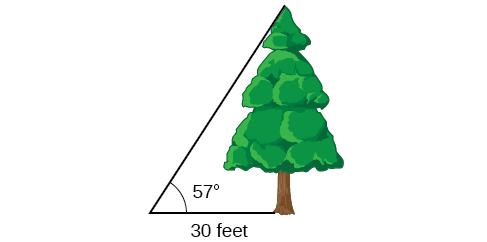
We know that the angle of elevation is
and the adjacent side is 30 ft long. The opposite side is the unknown height.
The trigonometric function relating the side opposite to an angle and the side adjacent to the angle is the tangent. So we will state our information in terms of the tangent of
letting
be the unknown height.
The tree is approximately 46 feet tall.
How long a ladder is needed to reach a windowsill 50 feet above the ground if the ladder rests against the building making an angle of
with the ground? Round to the nearest foot.
About 52 ft
Access these online resources for additional instruction and practice with right triangle trigonometry.
Visit this website for additional practice questions from Learningpod.
| Cofunction Identities |
For the given right triangle, label the adjacent side, opposite side, and hypotenuse for the indicated angle.* * *
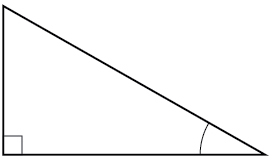
When a right triangle with a hypotenuse of 1 is placed in the unit circle, which sides of the triangle correspond to the x- and y-coordinates?
The tangent of an angle compares which sides of the right triangle?
The tangent of an angle is the ratio of the opposite side to the adjacent side.
What is the relationship between the two acute angles in a right triangle?
Explain the cofunction identity.
For example, the sine of an angle is equal to the cosine of its complement; the cosine of an angle is equal to the sine of its complement.
For the following exercises, use cofunctions of complementary angles.
For the following exercises, find the lengths of the missing sides if side
is opposite angle
side
is opposite angle
and side
is the hypotenuse.
For the following exercises, use [link] to evaluate each trigonometric function of angle
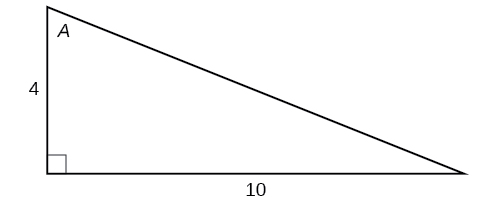
For the following exercises, use [link] to evaluate each trigonometric function of angle

For the following exercises, solve for the unknown sides of the given triangle.
For the following exercises, use a calculator to find the length of each side to four decimal places.
Find
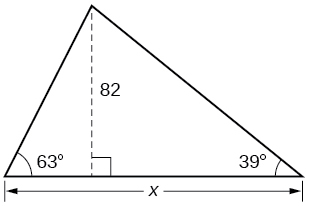
Find
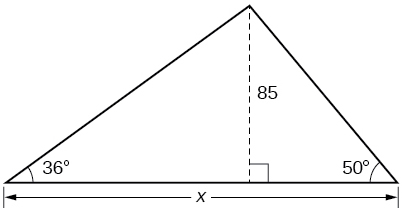
188.3159
Find
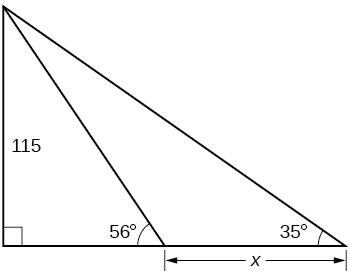
Find
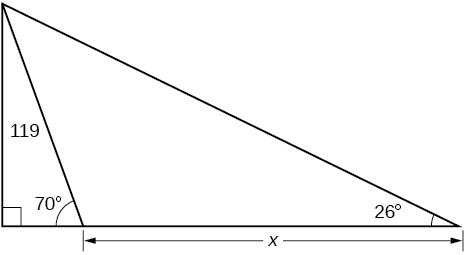
200.6737
A radio tower is located 400 feet from a building. From a window in the building, a person determines that the angle of elevation to the top of the tower is
and that the angle of depression to the bottom of the tower is
How tall is the tower?
A radio tower is located 325 feet from a building. From a window in the building, a person determines that the angle of elevation to the top of the tower is
and that the angle of depression to the bottom of the tower is
How tall is the tower?
498.3471 ft
A 200-foot tall monument is located in the distance. From a window in a building, a person determines that the angle of elevation to the top of the monument is
and that the angle of depression to the bottom of the tower is
How far is the person from the monument?
A 400-foot tall monument is located in the distance. From a window in a building, a person determines that the angle of elevation to the top of the monument is
and that the angle of depression to the bottom of the monument is
How far is the person from the monument?
1060.09 ft
There is an antenna on the top of a building. From a location 300 feet from the base of the building, the angle of elevation to the top of the building is measured to be
From the same location, the angle of elevation to the top of the antenna is measured to be
Find the height of the antenna.
There is lightning rod on the top of a building. From a location 500 feet from the base of the building, the angle of elevation to the top of the building is measured to be
From the same location, the angle of elevation to the top of the lightning rod is measured to be
Find the height of the lightning rod.
27.372 ft
A 33-ft ladder leans against a building so that the angle between the ground and the ladder is
How high does the ladder reach up the side of the building?
A 23-ft ladder leans against a building so that the angle between the ground and the ladder is
How high does the ladder reach up the side of the building?
22.6506 ft
The angle of elevation to the top of a building in New York is found to be 9 degrees from the ground at a distance of 1 mile from the base of the building. Using this information, find the height of the building.
The angle of elevation to the top of a building in Seattle is found to be 2 degrees from the ground at a distance of 2 miles from the base of the building. Using this information, find the height of the building.
368.7633 ft
Assuming that a 370-foot tall giant redwood grows vertically, if I walk a certain distance from the tree and measure the angle of elevation to the top of the tree to be
how far from the base of the tree am I?
For the following exercises, convert the angle measures to degrees.
For the following exercises, convert the angle measures to radians.
-210°
180°
Find the length of an arc in a circle of radius 7 meters subtended by the central angle of 85°.
10.385 meters
Find the area of the sector of a circle with diameter 32 feet and an angle of
radians.
For the following exercises, find the angle between 0° and 360° that is coterminal with the given angle.
For the following exercises, find the angle between 0 and
in radians that is coterminal with the given angle.
For the following exercises, draw the angle provided in standard position on the Cartesian plane.
-210°
75°
Find the linear speed of a point on the equator of the earth if the earth has a radius of 3,960 miles and the earth rotates on its axis every 24 hours. Express answer in miles per hour.
1036.73 miles per hour
A car wheel with a diameter of 18 inches spins at the rate of 10 revolutions per second. What is the car’s speed in miles per hour?
Find the exact value of
Find the exact value of
Find the exact value of
–1
State the reference angle for
State the reference angle for
Compute cosine of
Compute sine of
State the domain of the sine and cosine functions.
State the range of the sine and cosine functions.
For the following exercises, find the exact value of the given expression.
1
For the following exercises, use reference angles to evaluate the given expression.
If
, what is the
If
what is the
0.6
If
find
If
find
or
Which trigonometric functions are even?
Which trigonometric functions are odd?
sine, cosecant, tangent, cotangent
For the following exercises, use side lengths to evaluate.
0
For the following exercises, use the given information to find the lengths of the other two sides of the right triangle.
For the following exercises, use [link] to evaluate each trigonometric function.
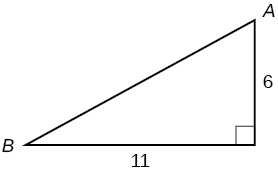
For the following exercises, solve for the unknown sides of the given triangle.
A 15-ft ladder leans against a building so that the angle between the ground and the ladder is
How high does the ladder reach up the side of the building?
14.0954 ft
The angle of elevation to the top of a building in Baltimore is found to be 4 degrees from the ground at a distance of 1 mile from the base of the building. Using this information, find the height of the building.
Convert
radians to degrees.
Convert
to radians.
Find the length of a circular arc with a radius 12 centimeters subtended by the central angle of
6.283 centimeters
Find the area of the sector with radius of 8 feet and an angle of
radians.
Find the angle between
and
that is coterminal with
Find the angle between 0 and
in radians that is coterminal with
Draw the angle
in standard position on the Cartesian plane.
Draw the angle
in standard position on the Cartesian plane.
A carnival has a Ferris wheel with a diameter of 80 feet. The time for the Ferris wheel to make one revolution is 75 seconds. What is the linear speed in feet per second of a point on the Ferris wheel? What is the angular speed in radians per second?
3.351 feet per second,
radians per second
Find the exact value of
Compute sine of
State the domain of the sine and cosine functions.
State the range of the sine and cosine functions.
Find the exact value of
Find the exact value of
Use reference angles to evaluate
Use reference angles to evaluate
If
what is the
If
find
Which trigonometric functions are even?
Find the missing angle:
Find the missing sides of the triangle
Find the missing sides of the triangle.
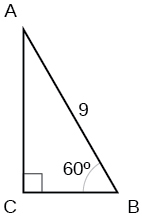
The angle of elevation to the top of a building in Chicago is found to be 9 degrees from the ground at a distance of 2000 feet from the base of the building. Using this information, find the height of the building.

You can also download for free at http://cnx.org/contents/fd53eae1-fa23-47c7-bb1b-972349835c3c@8.1
Attribution: